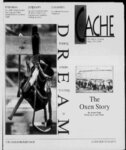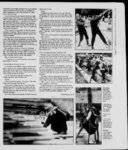| Show Opinion 16 Crossword 17 The Herald Journal Logan Utah Friday May 12 2000 ft 3 n t TV isssj ’kM" t t ’ : r i worry about their impact on the Cache unit V3 ' v'--? Lance Frazier outdoors editor By Wayne Iverson the sportsman representative on the Northern Regional Advisory Council said the Cache elk animals but that herd is near capacity with 2400-2Wwould change if wolves move! in "Wolves will definitely compete with hunters for resources especially for elk " Iverson said "but fanners and ranchers are probably a lot more concerned about having them here than sportsmen" Dennis Austin Northern Region biologist for the Utah ' Division of Wildlife Resources said wolves may not he that detrimental to big game over the long haul because they would thin out competing predators such as coy-til- K--- ' V T olves may be migrating back into Northern hiatus and some hunters fear their Utah after a 70-yeimpart on big game could he catastrophic Others predict the wolves will merely slip through the area without being noticed One thing is certain — although they’re rarely seen the shaggy predators draw plenty of interest wherever they go Tm sure they would drive (game) numbers down" ' said Curtis Dent who serves on the Cache Valley Wildlife Federation Board "They have had a devastating effect in Idaho" Five years ago the US Fish and Wildlife Service ' released 35 gray wolves in central Idaho as part of an ' experimental population Officials now estimate the state’s wolf population at about 145 animals and Dent said in some areas the big predators have nearly wiped out elk herds At one of his favorite hunting areas in the remote Frank Church Wilderness around the Middle Fork of the Salmon River Dent said he has seen few elk calves since thercintroduction and locals complained to him about losing pets to wolves Elk hunters are turning their ar "git pv liTJf National Park Services photo Top photo: The Rose Creek wolf pack runs near Elk Trail in the Lamar Valley Above: Two wolves relax in the Lamar Valley Outdoors ( es W 'TtV : attention elsewhere "Wolves have a serious impact on agriculture and hunting” Dent said “They eat people’s petsand “The overall impact' of one pack may he positive because of the wolves’ impact on coyotes and other' small predators” he noted Nonetheless having wolves’ Would “probably cause me to reduce the number of cow elk permits (on the Cache unit) by 100 a year" Austin has been sifting through the reported sightings of the past year None have been confirmed but he said it's likely the animals will appear and possibly even set- tie down here Between txigan Canyon Blacksmith Fork Canyon and Rich County he estimated the area has enough habitat and prey to support a doen wolves Fish and Wildlife Service formulas forecast that bringing in wolves reduces big game numbers by about five percent according to FWS biologist Ted Owens “I don’t think they would have a large impact on big game populations" Owens said "I wouldn't be surUtah Northern to was there enough space (in prised if interest a pack in staying but I don't know if tlicre's enough game "If they do come through w:c probably won't even know they’re there unless they're collared or have problems (with livestock predation)" Outdoor Life magazine devoted four pages of its April issue to the topic warning that wolves have “staggering See WOLVES on Page 14 Biologist claims whirling disease triumph Pack clinic By the Idaho State Journal The Bridgerland Backcountry Horsemen will host the third annual pack clinic from 9 am to 4 pm Saturday at the USU Indoor Horse Arena 1450 N- - 600 East Logan am and Registration is from is cost $20 Presenters will be Steve Guymon former teacher of USU's classes who will teach the basics forlheSawbuck packsaddle using panniers and the diamond hitch for the recreational packer and Clint Droll a former ranger in the Salmon District who will offer knowledge on hitches mantied loads and how to tie them on a Decker packsaddle A Dutch oven lunch will be provided along with helpful hints on Dutch oven cooking and the latest in light weight aluminum cookware from Camp Chef For information contact Travis 6 at horse-pocki- ng 753-650- Continued on Page 14 POCATELLO Idaho — A Montana fisheries biologist believes he has discovered how to save trout from a devastating disease hopeful news for fish fishermen and the and tourism-drive- n fishing- economies of the West Dick Vincent whirling disease research coordinator for the Montana Department of Fish Wildlife and Parks told the Idaho State Journal he has succeeded in "imprinting” three strains of rainbow trout The trout spawned earlier this spring and will hatch and begin to mature in water too cold for ideal whirling disease spore dispersal By the time water temperatures warm and millions of infectious spores are present the young fish likely will have matured enough to fend off a serious whirling disease attack "It was a success" Vincent said “We did get earlier spawning fish and that was one of our goals all along" “ think we’re moving in the right direction We’re not too far away from accomplishing our goals’ —Dick Vincent A severe whirling disease infection can be fatal to fish in the salmonid family which includes trout and salmon The disease has been found in most western states including Idaho Wyoming Utah Nevada California Washington and Oregon It also was discovered in Yellowstone National Park in 1998 Whirling disease affects only fish it is not harmful to humans who may eat infected fish While there is no known cure for the disease Vincent said he might have found a way to work around the deadly effects of the spore He worked in hatcheries for three years to coerce rainbow trout fry to hatch in colder water than usual Vincent theorized that these unusual conditions would prompt- the fish water to spawn in as well He hoped that as a result the fish eggs would hatch iii colder water and by the time peak TAM dispersal occurs the young fish would be strong enough to fend off a serious w hiding disease infection —- Whirling disease spores called — TAMs for short — thrive when water temperatures hover between 50 and 60 degrees Unfortunately for most strains of rainbow trout fry begin to hatch about the time spore dispersal peaks The spores attach themselves to the young fish and begin to eat away at the animals’ soft skeletal tissue Eventually damage to the tissue and the nervous system takes its toll and when excited the fish often swim in circles giving the disease its name The younger a fish is when exposed to TAMs the better chance it has of becoming seriously infected with whirling disease coldcr-than-norm- al released by infected fish “1 think we're moving in fhc right direction" Vincent said “We're not too far away from accomplishing our goals" - He said the final goal is to test the most hardy strain of rainbows — which has not yet been determined — in the Madison River a trophy Montana trout stream hit hard by a whirling disease infection Vincent and his staff are working with three strains of rainbow trout in Willow Creek — Eagle Lake rainbows a pure strain native to California DcSmct rainbows a mongrel strain commonly reared in western hatcheries: and Finger Lakes rainbows another "mutt" strain of rainbows found in the Finger luikes area of New York state Vincent said that of the three the Eagle Lake rainbows spawned sooner and should hatch sooner and in colder water than the other two Features: Sunday Focus: Golden Spike celebration Mm Whirling disease spores often come from the tuhifex worm a common food for trout Spores also can be M" 752-212- 1 it u |








































